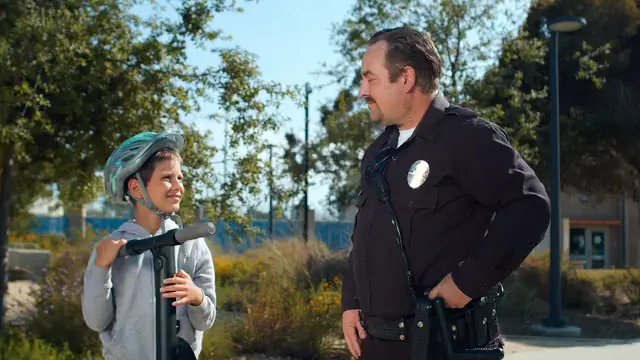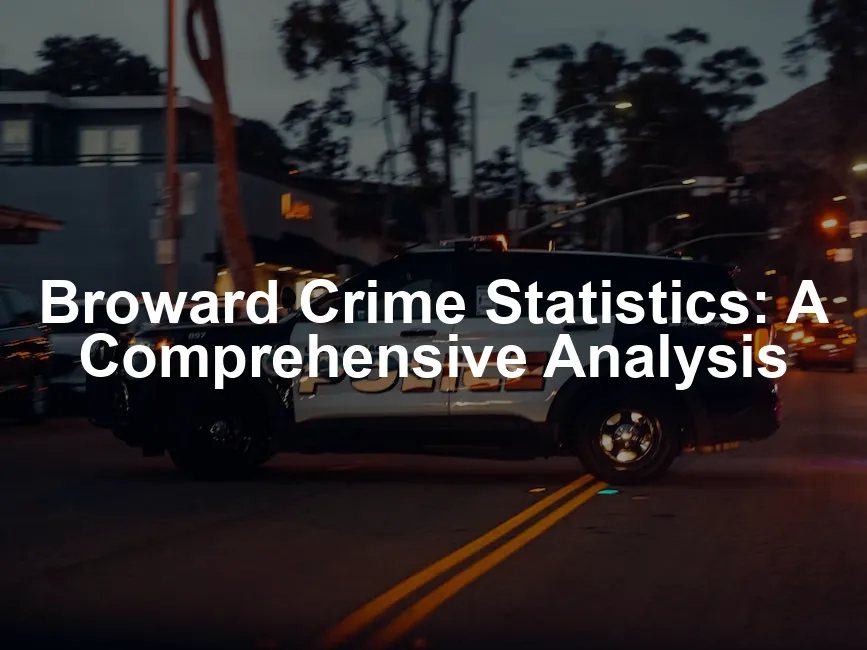Introduction
Welcome to Broward County, Florida – a vibrant region known for its sunny beaches, diverse communities, and, unfortunately, a crime rate that has some residents raising their eyebrows. With a population of nearly 2 million, Broward County is the second most populous county in the state. But what does that mean for safety?
Understanding crime statistics is crucial for residents and policymakers alike. They shed light on trends, highlight areas needing attention, and empower communities to take charge of their safety. This article aims to provide a thorough analysis of crime statistics in Broward County. We will cover trends, comparisons, and what these numbers mean for the everyday resident.
So, why should we care about crime statistics? Well, for starters, they inform us about where we live. Are we at risk of petty theft while grabbing a coffee? Is violent crime a concern in our neighborhood? These statistics influence community safety initiatives and shape public policy. When armed with knowledge, residents can better advocate for their safety.
In a nutshell, this article will help you navigate the murky waters of crime statistics in Broward County. By understanding the data, we can make informed decisions and foster a safer community for everyone.

Understanding Crime Statistics
What Are Crime Statistics?
Crime statistics are numerical representations of reported criminal activities in a specific area over a defined period. They provide valuable insights into the safety of communities and can help identify trends and patterns in criminal behavior. Essentially, these statistics are the report cards of our neighborhoods.
Reliable crime statistics are derived from various sources. The FBI, local law enforcement agencies, and the Florida Department of Law Enforcement (FDLE) are major players in this game. Each organization collects and reports data in distinct ways, contributing to a comprehensive picture of crime in Broward County.
Law enforcement agencies gather data through police reports, incident reports, and public records. They categorize crimes into different types, such as violent and property crimes, to better understand their prevalence. This categorization helps identify hot spots for crime and informs strategies for addressing them.
But why should we trust these statistics? They are often subject to rigorous checks and balances. For instance, the FBI’s Uniform Crime Reporting (UCR) program tracks crime across the nation, ensuring consistency in data reporting. Local agencies follow suit by adhering to state and federal guidelines.
Overall, crime statistics serve as a tool for accountability, transparency, and improvement. They empower communities to address issues and foster safer environments. So, the next time you hear about crime rates, remember – these numbers hold the key to understanding our world.

Types of Crime Statistics
Violent Crimes
Definition: Violent crimes involve physical harm or the threat of harm to individuals. They create a climate of fear and insecurity in communities. These crimes are serious and often result in significant emotional and psychological effects on victims.
Categories: The main categories of violent crimes include:
- Murder: The unlawful killing of another person, either intentional or unintentional. Broward County has seen fluctuations in murder rates that can trigger community discussions on safety and prevention. If you’re intrigued by the psychological depths behind crime, you might find Crime and Punishment by Fyodor Dostoevsky quite riveting.
- Rape: This crime involves forced sexual intercourse against a person’s will. It’s one of the most underreported crimes, making it hard to gauge its true prevalence.
- Robbery: This is stealing from a person with the use of force or intimidation. Unlike theft, robbery involves direct confrontation, which heightens its threat level.
- Aggravated Assault: This crime involves causing serious injury to another person or threatening them with a weapon. It’s crucial to understand that aggravated assault can escalate from minor disputes, showcasing the need for conflict resolution in communities.
Property Crimes
Definition: Property crimes are offenses that involve the theft or destruction of someone else’s property. They do not involve direct harm to individuals, but they significantly impact victims’ sense of security.
Categories: The key categories of property crimes include:
- Burglary: This crime involves entering a building unlawfully with the intent to commit theft or another crime. It can leave victims feeling violated in their own spaces.
- Larceny: This refers to the theft of personal property without the use of force. It includes shoplifting and theft of personal items, making it prevalent in various settings.
- Motor Vehicle Theft: This involves stealing a car or other motor vehicle. The increase in motor vehicle theft can often prompt local law enforcement to boost patrols and community awareness campaigns.

Broward County Crime Overview
Current Crime Rates
Broward County’s crime rates present a mixed bag, with both violent and property crimes higher than the national averages.
Violent Crime Rate: Currently, Broward County reports a violent crime rate of 25.1 incidents per 100,000 residents. This figure exceeds the national average of 22.7, indicating that residents face a greater risk of encountering violent crime. The spike in violent crime can be attributed to various factors, including socio-economic conditions and community dynamics.
Property Crime Rate: The property crime rate in Broward County stands at 47.5 per 100,000 residents, significantly above the national average of 35.4. This alarming statistic suggests that theft and burglary are prevalent, prompting community discussions on how to improve safety measures. The higher property crime rate may encourage local authorities to implement more proactive policing strategies and community engagement initiatives to combat theft and property damage.
Understanding these statistics is crucial for Broward County residents. They not only highlight the safety challenges faced but also serve as a call to action for community involvement and law enforcement collaboration. By being informed, residents can better advocate for safety measures that address these pressing issues.

For a comprehensive understanding of vital records in Broward County, you can check out this broward county vital statistics.
Yearly Trends in Crime Statistics
Historical Data
Broward County’s crime statistics tell a compelling story over the last decade. In the past ten years, crime rates have seen both ups and downs, much like a thrilling roller coaster ride. For instance, the violent crime rate stood at 3,807 incidents in 2004, showcasing a significant change in dynamics. Fast forward to 2020, and the number of violent crimes surged to approximately 7,022. This increase, while alarming, also reflects broader societal challenges, including economic fluctuations and community changes.
When we glance at property crime rates, a similar pattern emerges. The property crime rate in 2004 was roughly 3,050 incidents, but by 2020, it skyrocketed to 40,023. While the statistics may seem daunting, they also highlight the ongoing efforts by law enforcement to combat crime. More eyes on the streets often lead to better reporting and awareness, which helps communities stay informed and proactive.

Key Trends
Several key trends emerge from these statistics. First, there’s been a noticeable increase in both violent and property crimes over the last decade. The violent crime rate has risen from 3,807 to 7,022, signaling a need for enhanced community safety measures. However, it’s not all doom and gloom; some years have shown slight decreases, indicating that crime can ebb and flow.
Another trend involves the types of crimes committed. While violent crimes such as robbery and aggravated assault have captured headlines, property crimes like larceny and burglary remain the most prevalent. This suggests that while residents may feel threatened by violent crime, it’s often the home burglaries and thefts that hit closest to home. To delve deeper into the criminal psyche, consider reading Mindhunter: Inside the FBI’s Elite Serial Crime Unit by John E. Douglas.

Comparison with State and National Averages
State Level
When we compare Broward County’s crime statistics with Florida’s overall crime rates, some intriguing insights emerge. Broward County’s violent crime rate of 25.1 incidents per 100,000 residents surpasses the state average. Florida’s violent crime rate is lower, which raises questions about the unique challenges faced by Broward County. The property crime rate in Broward stands at 47.5, compared to Florida’s average of 35.4. This discrepancy signals that local law enforcement may need to tailor strategies specific to Broward’s dynamics to effectively tackle crime.
National Level
On the national stage, Broward County’s crime rates again show a marked difference. The county’s violent crime rate of 25.1 exceeds the national average of 22.7. This gap indicates that Broward residents face a higher risk of violent crime than many across the country. The property crime rate follows suit, with Broward’s 47.5 compared to the national average of 35.4. These comparisons highlight the urgent need for community engagement and law enforcement collaboration to address the rising crime rates, ensuring residents feel safe in their neighborhoods.

In summary, Broward County’s crime statistics reveal a complex landscape of rising crime rates compared to both state and national averages. Understanding these trends is essential for fostering community safety and encouraging proactive measures among residents and law enforcement alike. For a deeper understanding of criminal justice issues, you might want to check out The New Jim Crow: Mass Incarceration in the Age of Colorblindness by Michelle Alexander.
Rape
Statistics: In Broward County, the reported rape rate stands at 74.3 incidents per 100,000 residents. This figure is notably higher than the national average, indicating a pressing issue that demands attention. In 2020, there were approximately 1,429 reported cases of sexual assault, revealing the seriousness of this crime within the community.
Discussion: The trends surrounding rape and sexual assault in Broward County show fluctuating numbers, which can be influenced by various factors, including public awareness and community outreach initiatives. Local organizations have ramped up efforts to foster a supportive environment for survivors, encouraging reporting and emphasizing the importance of consent. However, the stigma surrounding sexual violence still poses challenges. Community responses have included educational campaigns aimed at prevention and support services for victims, showcasing a proactive stance against this heinous act.

Robbery and Assault
Statistics: Robbery rates in Broward County are reported at 296.4 incidents per 100,000 residents, while aggravated assault rates hit 517.2. These numbers highlight the urgency of addressing violent crime in the area, with 2,071 reported robberies in 2020 alone. If you’re curious about how crime impacts society, you might find The Long Shadow of the Past: The Impact of Crime on Society by David L. Faigman an eye-opener.
Discussion: The underlying causes of robbery and assault can be complex, often tied to socioeconomic factors such as poverty and lack of opportunities. Law enforcement agencies are stepping up efforts to combat these crimes through community policing initiatives and partnerships with local organizations. Increased patrols in high-risk areas, along with awareness programs, aim to deter potential offenders and encourage community involvement in safety measures.

Property Crimes in Broward County
Burglary
Statistics: Burglary incidents in Broward County reached approximately 9,600 in 2020, equating to a rate of 497.1 per 100,000 residents. This rate is significantly higher than the national average, illustrating a growing concern for property safety.
Discussion: The rise in burglary cases has prompted law enforcement to implement various prevention strategies. Neighborhood watch programs, increased community engagement, and the use of technology for surveillance are all part of the effort to protect residents. Educational initiatives on securing homes and reporting suspicious activities have also gained traction, empowering the community to take action. Looking to deepen your understanding of crime scene investigations? Check out Crime Scene Investigation: Methods and Procedures by David Fisher.

Larceny and Theft
Statistics: Larceny and theft incidents in Broward County clock in at around 30,000 reported cases, with a theft rate of 1,552.6 per 100,000 residents. This statistic underscores the prevalence of property crimes in the area.
Discussion: The implications of high larceny rates are significant for residents, as they often lead to heightened anxiety about safety and property security. Law enforcement has responded with targeted operations and increased visibility in neighborhoods. Additionally, community outreach programs aim to educate residents on preventive measures, such as securing valuables and reporting theft promptly, to mitigate the impact of these crimes.

Motor Vehicle Theft
Statistics: Motor vehicle theft rates in Broward County have reached 370 incidents per 100,000 residents, totaling approximately 3,000 cases in 2020. This statistic reflects a concerning trend in vehicle safety.
Discussion: The rising trend in motor vehicle theft has led to intensified law enforcement efforts, including increased patrols and community awareness campaigns. Local authorities are collaborating with auto manufacturers to promote anti-theft devices and educate residents on the importance of securing their vehicles. By fostering community vigilance, these initiatives aim to reduce incidents and enhance overall public safety. If you’re curious about how trauma can affect one’s life, consider reading The Body Keeps the Score: Brain, Mind, and Body in the Healing of Trauma by Bessel van der Kolk.

Crime in Nearby Cities
Comparative Analysis
Broward County isn’t an island; it’s surrounded by cities with their own unique crime dynamics. Let’s take a closer look at Lauderhill, Plantation, and Fort Lauderdale, shall we?
Lauderhill has a violent crime rate of 784.9 incidents per 100,000 residents. That’s quite the number! When it comes to property crime, it sits at 2,929.4 incidents per 100,000 residents. These figures paint a picture of a city grappling with crime, perhaps fueled by economic factors and social challenges. If you’re keen to explore how crime fiction often mirrors reality, you might enjoy The Innocent Man: Murder and Injustice in a Small Town by John Grisham.
Moving on to Plantation, the crime stats tell a different story. The violent crime rate is significantly lower at 221.0 incidents per 100,000 residents, while property crime stands at 2,700.2 incidents per 100,000 residents. This suggests Plantation is doing something right, possibly through effective community policing and resident engagement.

Now, let’s not forget Fort Lauderdale. With a violent crime rate of 594.3 incidents per 100,000 residents and a property crime rate of 4,915.4 incidents per 100,000 residents, it appears Fort Lauderdale is in a bit of a pickle. The higher rates may stem from its bustling tourism and nightlife, which can attract both visitors and criminal activity. For those interested in the darker side of history, The Devil in the White City by Erik Larson is a compelling read.
When compared to Broward County’s overall violent crime rate of 25.1 and property crime rate of 47.5, it’s clear that not all neighboring cities are equal in crime prevalence. This disparity raises questions about resource allocation and crime prevention strategies among these cities.

Similar-Sized Cities
Let’s expand our scope and compare Broward County to similar-sized cities across the U.S., like Jacksonville and Atlanta.
In Jacksonville, the violent crime rate is 647.4 incidents per 100,000 residents, and property crime stands at 3,309.5 incidents per 100,000 residents. This suggests that Jacksonville faces challenges somewhat akin to Broward County, but with slightly lower violent crime rates.
Then there’s Atlanta, which is known for its vibrant culture but also for higher crime rates. Atlanta has a violent crime rate of 768.8 incidents per 100,000 residents and property crime at 4,654.4 incidents per 100,000 residents. The numbers here are considerably higher than those in Broward County, making it clear that crime is a pressing issue in urban centers. If you’re interested in understanding the psychology behind criminal behavior, you should consider The Psychology of Criminal Conduct by D.A. Andrews.

These comparisons reveal that while Broward County has its struggles, it’s not alone in the fight against crime. The implications are significant; cities with similar challenges often turn to innovative policing strategies and community programs to curb crime. There’s no one-size-fits-all solution, but sharing best practices could be a step in the right direction.
The lessons learned from these cities can help Broward County refine its approach. After all, understanding the crime landscape is crucial for building safer communities.
Community Response and Law Enforcement
Law Enforcement Strategies
The Broward County Sheriff’s Office is no stranger to implementing innovative strategies to combat crime. Among their initiatives, community policing has emerged as a key focus. This approach encourages deputies to build relationships within neighborhoods, fostering trust and collaboration.
Programs like the Neighborhood Watch empower residents to take an active role in monitoring their communities. It’s like having a built-in security system, but with friendly neighbors instead of cameras! Additionally, the Sheriff’s Office runs various educational workshops aimed at crime prevention. Topics range from personal safety to home security, enabling residents to feel more secure in their daily lives. If you’re curious about the broader implications of community policing, you might find The Gift of Fear: Survival Signals That Protect Us from Violence by Gavin de Becker enlightening.
Another notable initiative is the Youth Programs that engage younger residents. By providing mentorship and recreational activities, these programs not only keep kids off the streets but also cultivate a sense of community pride. When young people see law enforcement as allies instead of adversaries, everyone benefits.

Trends and Future Directions
Based on current data, predicting future crime trends in Broward County can be tricky. However, some patterns are emerging. Experts suggest that as the community becomes more engaged, crime rates may experience a gradual decline. Increased awareness often leads to proactive measures, and that’s a win for everyone.
To further reduce crime, a collaborative approach is essential. Residents should consider forming more neighborhood groups to share information and report suspicious activity. Law enforcement, on the other hand, should continue to strengthen partnerships with local organizations and community leaders.
Recommendations for residents include staying vigilant and participating in community events. The more involved everyone is, the safer Broward County can become. It’s all about teamwork—after all, safety is a shared responsibility.
In conclusion, Broward County faces challenges, but with a strong community response and effective law enforcement strategies, there’s hope for a safer tomorrow. Understanding crime statistics is the first step in fostering a proactive, engaged community that works together to combat crime. If you’re looking for an insightful read on the societal implications of crime, consider The Anatomy of Violence: The Biological Roots of Crime by Adrian Raine.
Please let us know what you think about our content by leaving a comment down below!
Thank you for reading till here 🙂
All images from Pexels




